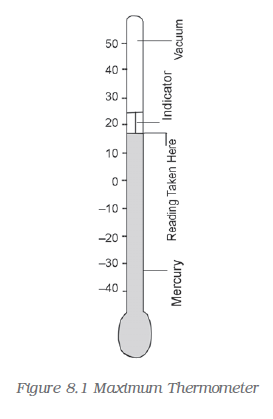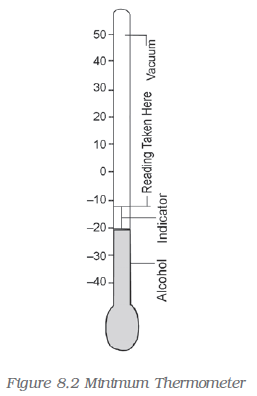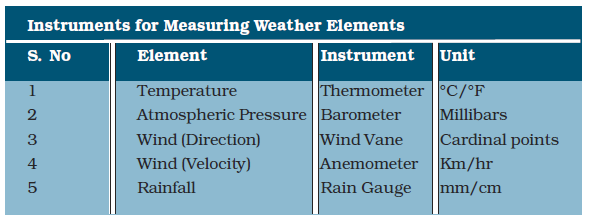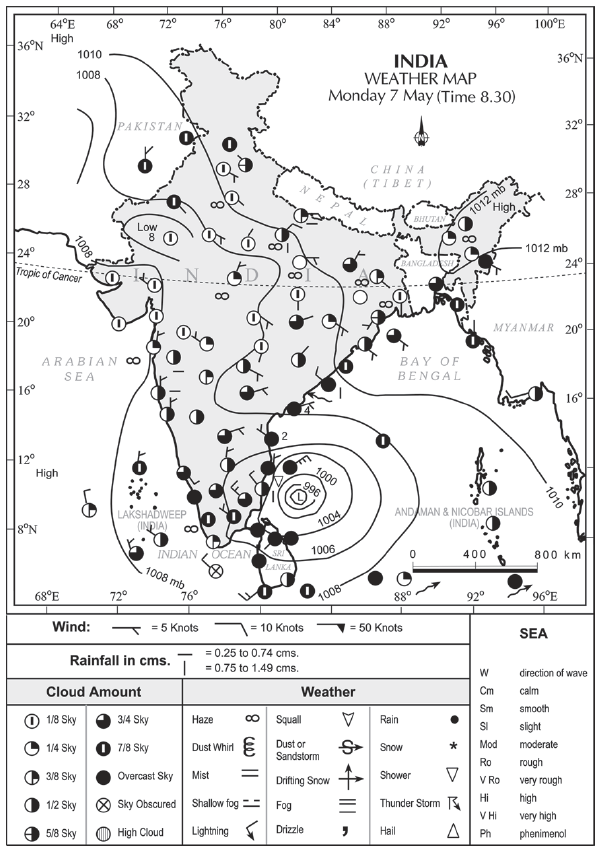Table of Contents

Chapter 8
Weather Instruments, Maps and Charts
Weather denotes the atmospheric conditions of weather elements at a particular place and time. The weather elements include temperature, pressure, wind, humidity and cloudiness. Each day weather maps are prepared for that day by the Meteorological Department from the data obtained from observations made at various weather stations across the world. In India, weather-related information is collected and published under the auspices of the Indian Meteorological Department, New Delhi, which is also responsible for weather forecasting.
Indian Meteorological Department
The Indian Meteorological Department (IMD) was established in 1875, with its headquarters at Calcutta. The IMD headquarters are presently located at New Delhi.
Weather forecasts help in taking safety measures in advance in case of the likelihood of bad weather. Predicting weather a few days in advance may prove very useful to farmers and to the crew of ships, pilots, fishermen, defence personnel, etc.
Glossary
1. Weather : The condition of the atmosphere at a given place and time with respect to atmospheric pressure, temperature, humidity, precipitation, cloudiness and wind. These factors are known as weather elements.
2. Weather Forecast : Prediction with a reasonable amount of certainty about the conditions of weather that would prevail in the coming 12 to 48 hours in a certain area.
Weather Observations
Globally, meteorological observations are recorded at three levels, viz. surface observatories, upper air observatories and space-based observation platforms. The World Meteorological Organization (WMO), a specialised agency of the United Nations, coordinates these observations.
Surface Observatories
A typical surface observatory has instruments for measuring and recording weather elements like temperature (maximum and minimum), air pressure, humidity, clouds, wind and rainfall. Specialised observatories also record elements like radiation, ozone atmospheric trace gases, pollution and atmospheric electricity. These observations are taken all over the globe at fixed times of the day as decided by the WMO and the use of instruments are made conforming to international standards, thus making observations globally compatible.
In India, meteorological observations are normally classified into five categories depending upon their instruments and the number of daily observations taken. The highest category is Class-I. Typical instrumental facility available in a Class-I observatory consists of the following:
» Maximum and minimum thermometers
» Anemometer and wind vane
» Dry and Wet bulb thermometer
» Rain gauge
» Barometer
Observations are taken in these observatories normally at 00,03,06,09,12,15,18,21 hours (Greenwich Mean Time) around the globe. However, for logistic reasons, some of the observatories take limited number of daily observations upper air observation during daytime only.
Space-based Observations
Weather satellites make comprehensive and large-scale observations of different meteorological elements at the ground level as well in the upper layers of the atmosphere. The geo-stationary satellites provide space-based observations about weather conditions (refer to Chapter 7). For example, The Indian National Satellite (INSAT) provides valuable observations of temperature, cloud cover, wind and associated weather phenomena.
Weather Instruments
Various instruments are used for measuring different weather phenomena. Some of the common but important weather instruments are listed below.
Thermometer
Thermometer is used to measure air temperature. Most thermometers are in the form of a narrow closed glass tube with an expanded bulb at one end. The bulb and the lower part of the tube are filled with liquid such as mercury or alcohol. Before the other end is sealed off, the air in the tube is released by heating it. The bulb of the thermometer in contact with the air gets heated or cooled, as the case may be, as a result of which the mercury in the bulb rises or falls. A scale is marked on the glass tube and readings are taken from there.
The two most common scales used in thermometers are Centigrade and the Fahrenheit. On the Centigrade thermometer, the temperature of melting ice is marked 00C and that of boiling water as 1000C, and the interval between the two is divided into 100 equal parts. On the Fahrenheit thermometer, the freezing and boiling points of water are graduated as 320F and 2120F respectively.
While the maximum thermometer and minimum thermometer are used to measure the air temperature, the dry bulb and the wet bulb thermometers are used to determine the humidity in the air. A set of these thermometers is kept in the Stevenson Screen (Box 8.2).
Stevenson Screen
The Stevenson screen is designed to protect thermometers from precipitation and direct sunlight while allowing air to circulate freely around them. It is made from wood with louvered sides to allow free and even flow of air. It is painted white to reflect radiation. It stands on four legs and is about 3 feet 6 inches above the level of the ground. The legs must be sufficiently rigid and be buried sufficiently in the ground to prevent shaking. The front panel is hinged at the bottom to form a door, which allows for maintenance and reading of the thermometers. The door of Stevenson screen is always towards the north in the northern hemisphere and towards the south in the southern hemisphere because direct sunrays also affect mercury. The purpose of the Stevenson screen is to create a uniform temperature enclosure that closely represents the same temperature as the air outside.
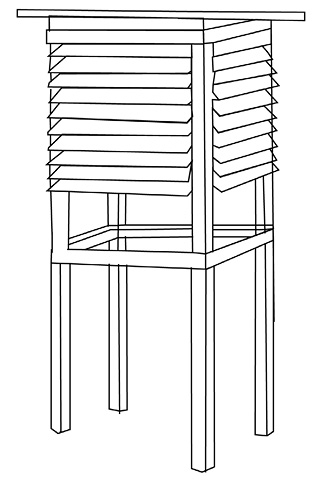
The maximum thermometer is designed to record the highest temperature during a day. As the temperature increases, the mercury moves up into the tube; however, as the mercury cools, it cannot move downwards because of a constriction in the tube. It must be reset again to bring it down. The minimum thermometer records the lowest reading in a day. In this thermometer, alcohol is used in place of mercury. When the temperature decreases, the metal pin in the tube goes down and strikes at the minimum temperature. (Fig. 8.1 Maximum and Fig. 8.2 Minimum Thermometers).
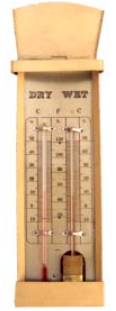
Figure 8.3 Wet and Dry Bulb Thermometer
The dry bulb and wet bulb thermometers are used for measuring humidity in the air (Fig. 8.3). The dry bulb and wet bulb thermometers are two identical thermometers fixed to a wooden frame. The bulb of the dry thermometer is kept uncovered and is exposed to the air while the bulb of the wet bulb thermometer is wrapped up with a piece of wet muslin, which is kept continuously moist by dipping a strand of it into a small vessel of distilled water. The evaporation from the wet bulb lowers its temperature.
Dry bulb readings are not affected by the amount of water vapour present in the air, but the wet bulb readings vary with it since the rate of evaporation is dependent upon the amount of water vapour present in the air. The greater the humidity in the air, the slower the rate of evaporation and hence, the difference between the readings of the dry bulb and wet bulb will be small. On the other hand, when the air is dry, the evaporation from the surface of the wet bulb is rapid, which would lower its temperature and the difference between the two readings would be larger. Hence, the difference of the readings of the dry bulb and the wet bulb thermometers determines the state of the atmosphere with regard to its humidity. The larger the difference, the more arid is the air.
Barometer
The air around us has weight, and it exerts great pressure on the earth’s surface. At the sea level, under normal conditions, the pressure of air is 1.03 kg per square centimetre. Due to constant movement of air, change in temperature and variation in its vapour content, the weight of the air changes continuously with time and place.
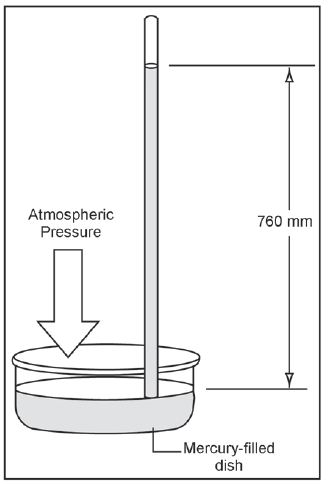
Figure 8.4 Mercury Barometer
The instrument used to measure atmospheric pressure is called a barometer. The most commonly used barometers are the mercury barometer, aneroid barometer and barographs. The unit of measurement is in the millibar. Mercury barometer is an accurate instrument and is used as a standard. In it the atmospheric pressure of any place is balanced against the weight of a column of mercury in an inverted glass tube. The principle of a mercurial barometer can be explained by a simple experiment (Fig. 8.4). Take a thick glass tube of uniform length about a meter long and fill it with mercury. Close the mouth of the tube with a finger, then invert and immerse its open end in a cup of mercury without allowing air to enter into the tube and then remove the finger.
The mercury will flow out of the tube into the cup and stand at a definite height above the level of the liquid in the cup. This is because the weight of the column of the mercury in the tube, above the surface of the mercury in the cup, is balanced by the weight of the air column of an indefinite height exerted as pressure upon an equal cross-section of the liquid surface. The height of the column of mercury in the tube, therefore, becomes the measure of the pressure of air.
Aneroid barometer gets its name from the Greek work, aneros (a- ‘not’, neros – ‘moisture’, meaning without liquid). It is a compact and portable instrument. It consists of a corrugated metal box made up of a thin alloy, sealed completely and made airtight after partial exhaustion of air. It has a thin flexible lid, which is sensitive to changes of pressure. (Fig. 8.5)
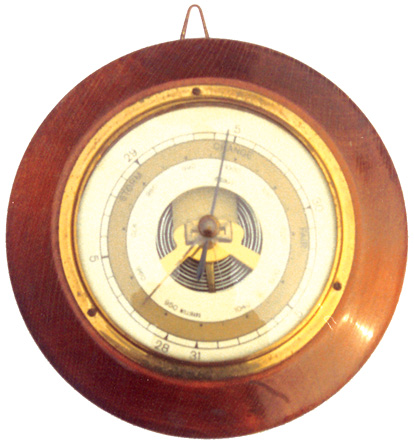
Figure 8.5 Aeniroid Barometer
As the pressure increases, the lid is pressed inward, and this, in turn, moves a system of levers connected to a pointer, which moves clockwise over the graduated dial and gives higher reading. When the pressure decreases, the lid is pushed outward and the pointer moves counter clockwise, indicating lower pressure.
Barograph works on the principle of aneroid barometer. There are a number of vacuum boxes placed one above the other so that the displacement is large. A system of levers magnifies this movement which is recorded by a pen on a paper attached to a rotating drum. The readings of a barograph are not always accurate, and therefore, they are standardised by comparing them with a mercury barometer reading.
Wind Vane
Wind vane is a device used to measure the direction of the wind. The wind vane is a lightweight revolving plate with an arrowhead on one end and two metal plates attached to the other end at the same angle. This revolving plate is mounted on a rod in such a manner that it is free to rotate on a horizontal plane. It responds even to a slight blow of wind. The arrow always points towards the direction from which the wind blows. (Fig. 8.6)
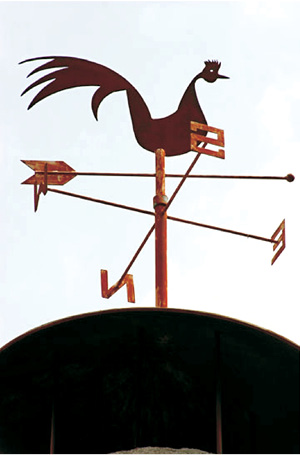
Figure 8.6 Wind Vane
Rain Gauge
The amount of rainfall is measured with the help of a rain gauge. The rain gauge consists of a metal cylinder on which a circular funnel is fitted. The diameter of the funnel’s rim is normally 20 cm. The rain drops are collected and measured in a measuring glass. Normally, rainfall is measured in the units of millimetres or centimetres. Snow is also measured in a similar manner by turning it into liquid form (Fig. 8.7).
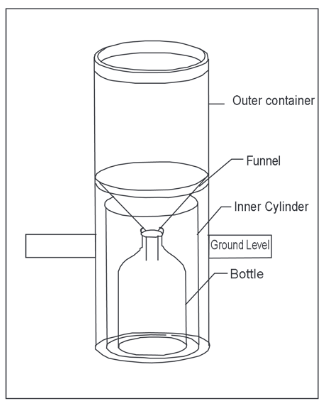
Figure 8.7 Rain Gauge
Weather Maps and Charts
Weather Maps: A weather map is the representation of weather phenomena of the earth or a part of it on a flat surface. It depicts conditions associated with different weather elements such as temperature, rainfall, sunshine and cloudiness, direction and velocity of winds, etc. on a particular day. Such observations being taken at fixed hours are transmitted by code to the forecasting stations. The central office keeps a record of the observations, which forms the basis for making a weather map. The upper air observations which are procured from hill stations, aeroplanes, pilot balloons, etc. are plotted separately. Since the inception of the Indian Meteorological Department, the weather maps and charts are prepared regularly.
Meteorological observatories transmit the data to the Central Observatory at Pune twice a day. Data is also collected on ships plying on the Indian seas. A good progress has been made in the field of weather forecasting and observation with the establishment of weather observatories in Antarctica, the International Indian Ocean Expedition, and the launching of rockets and weather satellites.
Weather Charts: The data received from various weather observatories are in plenty and detailed. As such, they cannot be incorporated in one single chart unless the coding designed to give the economy of expression is used. These are called synoptic weather charts and the codes used are called meteorological symbols. Weather charts provide the primary tools for weather forecasting. They help in locating and identifying different air masses, pressure systems, fronts and areas of precipitation.
Weather Symbols
The messages received from all the observatories are plotted on the map using weather symbols standardised by the World Meteorological Organisation and the National Weather Bureaus. (Figures 8.8 and 8.9)To facilitate the interpretation of the plots, each element occupies a fixed position to the station circle as given in Figures 8.8 and 8.9.
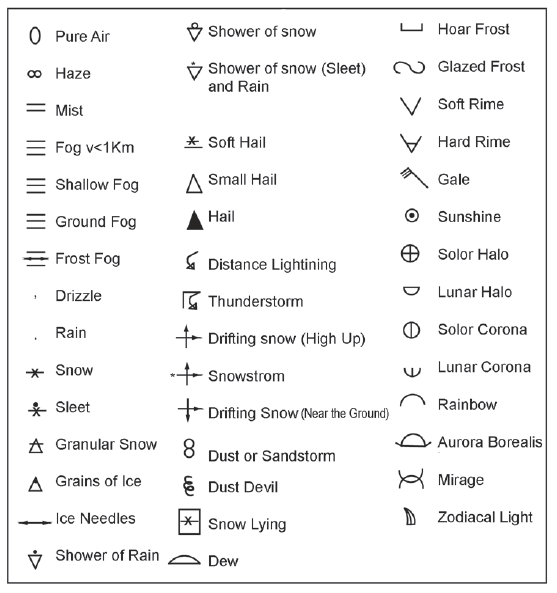
Figure 8.8 Meteorological Symbols (Approved by the International Meteorological Organisation, Warsaw, 1935)
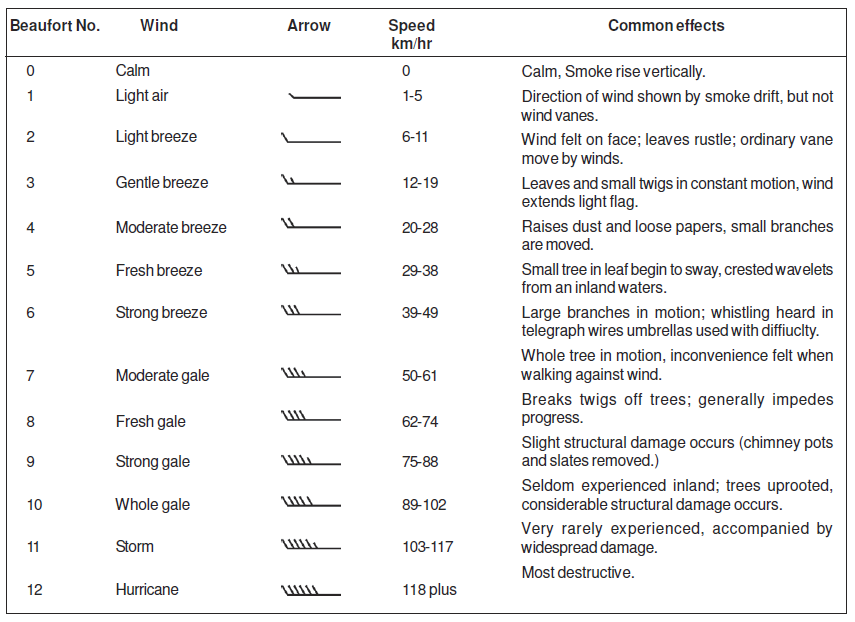
Figure 8.9 Wind Speed and Common Effects
Mapping the Climate Data
Much of the climatic data is represented by line symbols. The most common of these are the isometric lines.These lines are depicted on the map as isopleths. The Isopleth can be interpolated for places having the same mean values of temperature, rainfall, pressure, sunshine, clouds, etc. Some of these lines and their uses are mentioned below:
Isobars : Lines connecting places of equal air pressure.
Isotherms : Lines connecting places of equal temperature.
Isohyets : Lines connecting places of equal amount of rainfall over a given period of time.
Isohels : Lines connecting places of same mean daily duration of
sunshine.
Isonephs : Lines connecting places of same mean value of cloud cover.
Weather Map Interpretation
On the basis of the above information, we can analyse a weather map and understand the general pattern of weather conditions prevailing in different parts of the country. In Fig. 8.10 the general weather conditions prevailing in India during the month of May are plotted. There is a general increase of pressure towards the north and north-east. Two low-pressure centres can be identified with one over Rajasthan and the other over the Bay of Bengal. The low pressure centre is well developed over the Bay of Bengal marked by concentric isobars, with the lowest air pressure being 996 mb. The southern part of India has overcast skies. The central part of India, on the other hand, has generally clear skies. In the southern part of the eastern coast, the winds are mostly from the land to the sea, flowing in an anti-clockwise direction. Also, read Fig. 8.12 and find out the temperature and pressure conditions in July.
In Figures 8.11 and 8.13, the general weather conditions during winters in the month of January are plotted. There is a general increase of pressure towards the north from south. Most of the country has clear skies with a high-pressure region developing to the eastern side of India. The highest pressure isobar of 1018 mb passes through Rajasthan.
Figure 8.10 Indian Weather Map (for the month of May)
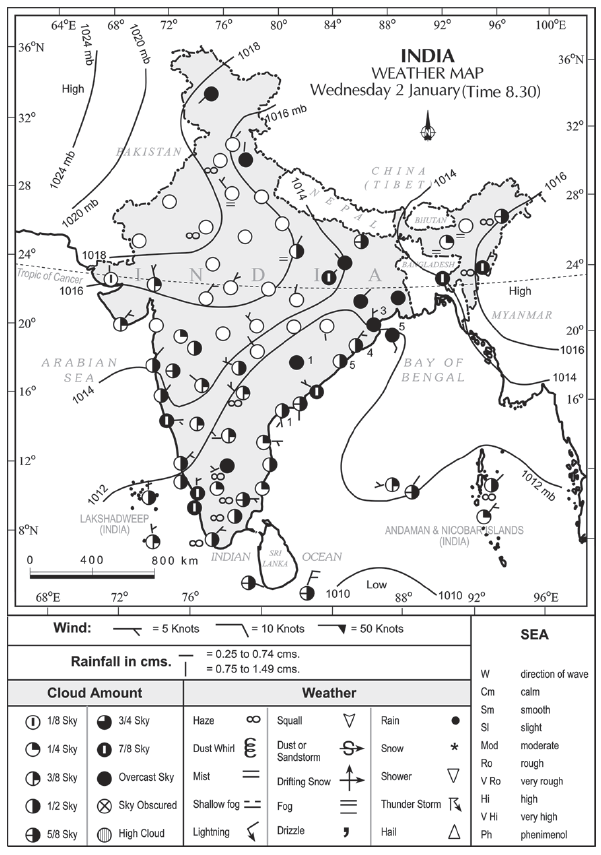
Figure 8.11 Indian Weather Map (for the month of January)
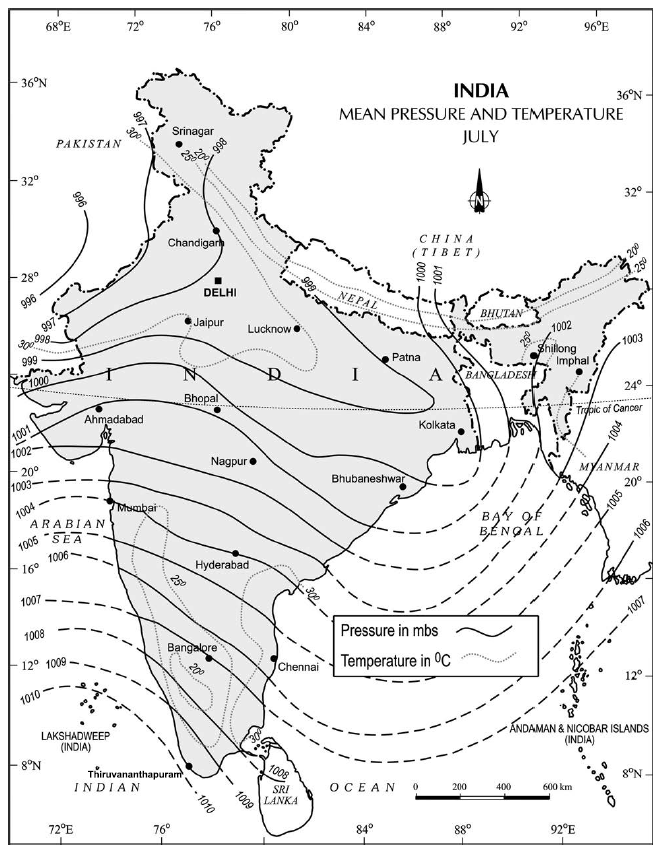
Figure 8.12 India - Mean Pressure and Temperature (January)
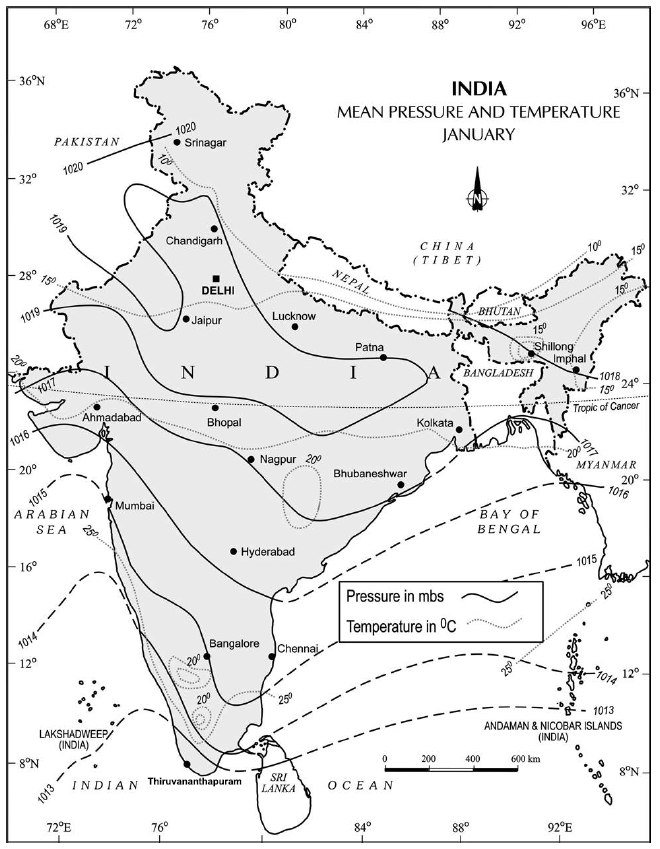
Figure 8.13 Mean Pressure and Temperature (July)
Exercises
1. Choose the right answer from the four alternatives given below.
(i)Which department prepares the weather map of India for each day?
(a) The World Meteorological Organisation
(b) The Indian Meteorological Department
(c) The Survey of India
(d) None of these
(ii)Which two liquids are used in maximum and minimum thermometers?
(a) Mercury and water
(b) Water and alcohol
(c) Mercury and alcohol
(d) None of these
(iii)Lines connecting the places of equal pressure are called
(a) Isobars
(b) Isohyets
(c) Isotherms
(d) Isohels
(iv)The primary tool for weather forecasting is
(a) Thermometer
(b) Barometer
(c) Maps
(d) Weather charts
(v)If there is more humidity in the air, the difference between the readings of a dry bulb and a wet bulb will be
(a) Less
(b) More
(c) Equal
(d) None of these
2. Answer the following questions in about 30 words.
(i)What are the basic elements of weather?
(ii)What is a weather chart?
(iii)Which instruments are normally available in Class-I observatory to measure the weather phenomena?
(iv)What are Isotherms?
(v) Which meteorological symbols are used to mark the following on a weather map?
a) Rain
b) Mist
c) Sunshine
d) Lightning
e) Overcast Sky
3. Answer the following question in not more than 125 words.
Discuss how weather maps and charts are prepared and how they are useful to us.
Map Reading
Study the Figures 8.12 and 8.13 and answer the following questions.
(a) Which seasons are shown in these maps?
(b) What is the value of the highest isobar in Figure 8.12 and through which part of the country does it pass?
(c) What are the values of the highest and the lowest isobars in Figure 8.13 and where are they located?
(d) What are the patterns of temperature distribution in both the maps?
(e) In which parts do you see the highest and the lowest mean temperature in Figure 8.12?
(f) What relationship do you see between the distribution of temperature and pressure in both the maps?
